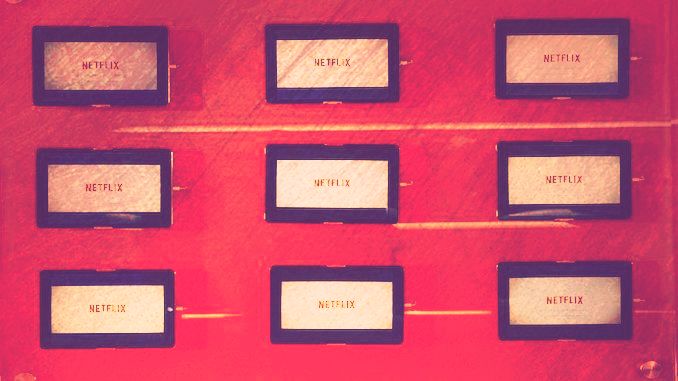
- Sony Pictures Wisely Opts Out of Direct Streaming and Splits Film Rights Between Netflix and Disney
- Major Content Licensing Deals in the U.S. (Updated)
- Worldwide Film & Television Distribution Intelligence
- Netflix’s Content Strategy: Localized Content vs. Global Appeal
- FilmTake Away: Netflix Enters Advertising as it Flips from Linear to Online
Rising costs and changing viewer preferences have altered Netflix’s global content strategy. For years, executives have touted original programming as the future at Netflix, but over the last six years, originals have decreased from 60% to 40% of its streaming catalog.
This shift is welcome news for distributors that have grown wary of content exclusivity and are again licensing films and shows to their streaming competitors, especially Netflix.
Sony Pictures Wisely Opts Out of Direct Streaming and Splits Film Rights Between Netflix and Disney
Netflix emerged as the winner in a nearly two-year auction process for the exclusive U.S. rights to stream Sony’s theatrical releases in the lucrative Pay-One Window, which started with the studio’s 2022 slate. Typically, the Pay-One Window lasts 18 months and follows theatrical and home entertainment windows that have significantly contracted in recent years.
Before its deal with Netflix, Sony’s PayTV partner was Lionsgate-owned Starz, which started in 2006.
Starting last year, all films from the various Sony banners, including Columbia Pictures, Sony Pictures Classics, Screen Gems, and TriStar Pictures, will stream exclusively on Netflix in the United States after theatrical and home entertainment windows. Sony has decided to hold onto international streaming rights for a more piecemeal licensing approach.
The agreement also provides Netflix a first-look at Sony’s original films produced for the direct-to-streaming market, which start upon signing in April 2021. However, Netflix has the right to refuse any title, freeing Sony to pursue other streaming partners.
Major Content Licensing Deals in the U.S. (Updated)
| Film Studio | Film Slate | Pay-One Window | Pay-Two Window, etc. |
|---|---|---|---|
| Disney | Disney | Disney+ | N/A |
| Disney | 20th Century Fox / Searchlight | Disney+ / Hulu / HBO / Max | N/A |
| A24 | A24 | HBO / Max / Cinemax | N/A |
| Neon | Neon | Hulu | N/A |
| Lionsgate | Lionsgate Films | Starz | N/A |
| Lionsgate | Summit | Starz | N/A |
| MGM | MGM | MGM+ | Amazon / Paramount+ |
| Paramount | Paramount | Paramount+ | MGM+ |
| Sony | Sony Pictures | Netflix | All Disney Platforms |
| Universal | Animated Films | Peacock / Netflix | Netflix |
| Universal | Live-Action Films | Peacock / Amazon | Starz |
| Warner Bros. | Warner Bros. | HBO / Max | N/A |
Like most licensing agreements, the deal is structured traditionally, whereby Netflix pays for each film determined by rate cards on a sliding scale by each title’s box office receipts. As part of the agreement, Netflix will also license an unspecified number of older titles from Sony’s film library.
Weeks after its deal with Netflix, Sony Pictures reached a major licensing agreement with Disney to offer both feature and animated films in the Pay-Two Window for its theatrical slate from 2022-2026.
After the Pay-One Window with Netflix, most of Sony’s film library will be available on Disney’s streaming and T.V. platforms, including Disney+, Hulu, ABC, Disney Channels, and FX. Before the most recent mega-deal, Sony only licensed its films to Disney-owned FX in the post-Pay-One Window.
Sony is the only major studio without a direct-to-consumer streaming service. It has wisely declared that it will focus on supplying content to others rather than wading into the profit-challenged streaming wars.
Discover What Streamers Like Netflix Pay to License Third-Party Films and Television Shows Around the World with Distribution Intelligence from FilmTake.
Worldwide Film & Television Distribution Intelligence
Get unparalleled access to market intelligence reports that draw on financial data and insights from dozens of content distribution deals worldwide between key industry participants.

Film and Series distribution rates and terms deriving from dozens of agreements for rights to transmit films and episodic television via PayTV and SVOD.
Choose flexible options for single-user PDF downloads.
Licensing Terms & Included Programs:
Pay-1 & SVOD Rate Cards for Motion Pictures and Series Exhibited Worldwide in Multiple Availability Windows
- Motion Pictures: Pay-1, First Run, Second Window Features, Recent Library Features (Tiers AAA,A,B,C), Library Features (Tiers AAA,A,B,C), Current and Premium Made-For-TV Films and Direct-To-Video Films, covering many license periods over the last decade
- Episodic TV: Current, Premium, Premium Catalog (1HR & 1/2HR), Catalog Series (1HR & 1/2HR), and Catalog Miniseries + Case Studies on Current Mega Hit, Catalog Mega Hit, and Premium Catalog, covering many licensing terms from 2012-2024
- Because most-favored-nation rates operate in practice, the rates and terms apply to a diverse range of content and distributors worldwide in multiple availability windows.
Netflix’s Content Strategy: Localized Content vs. Global Appeal
Netflix will retain its position as the top investor in global streaming content by spending $15 billion, a moderate 2% increase from last year. In contrast, its competitors Disney+, Paramount+, and Apple TV+ will increase content spending by 10% in 2024.
Netflix has spent heavily on local productions in many diverse regions, exemplified by its significant investments in German and Korean programming. This approach aims to make shows that resonate primarily in the markets they were created. However, local content’s success varies by region. In countries like South Korea, local content accounts for a substantial portion of viewership. Yet, in many other markets, the dominance of American originals remains unshaken.
Substantial investments in international content have ensured a continuous stream of fresh, non-U.S. films and shows for Netflix despite interruptions from strikes and other industry dynamics. While the content has flowed steadily, non-English episodic television seasons have yet to make a comparable impact on subscriber growth or retention, outside a few examples.
Despite Herculean efforts, Netflix’s success still hinges on English-language series produced in the U.S., which continue to dominate the streaming service and raise questions about the extent international content can drive the platform’s growth.
For instance, Netflix doubled its content budget for German-language content to half a billion dollars between 2021 and 2023. Despite these efforts, local originals made up less than 3% of the viewing time by German subscribers.
Even with glowing projections of a newly globalized content market driving subscriber growth, global blockbuster episodic hits outside the U.S. like “Squid Game” are a rarity.
FilmTake Away: Netflix Enters Advertising as it Flips from Linear to Online
As linear television advertising is imploding, streaming advertising is exploding. This timing spells more success for Netflix, which has avoided expensive legacy costs and is entering the advertising market at an opportune time.
Netflix’s introduction of an ad-supported tier marks a significant shift in its business model. This shift aims to broaden its subscriber base and diversify revenue streams. It also reflects a pragmatic response to the evolving demands of content consumers and advertisers.
Netflix’s ad-supported tier has seen a nearly 70% increase in membership quarter-over-quarter, accounting for about 30% of all new sign-ups. This growth indicates a shift towards diversifying revenue streams and meeting various consumer preferences in a dynamic and complex market.
However, to fully realize advertising success, Netflix must follow through on its recent pledge to provide greater transparency in viewership data. By offering more detailed viewership insights, Netflix addresses the demands of creators, advertisers, and investors for more accurate and accessible data.